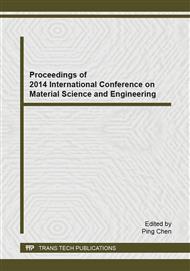p.303
p.307
p.315
p.321
p.325
p.330
p.334
p.339
p.344
Coaxial Poly (Phenylene Vinylene)/Carbon Nanotube Nanocomposites
Abstract:
Coaxial nanocomposites were prepared by in–situ chemical polymerization of 4– dibromomethyl–2,5–2–octyloxy phenylene in the presence of multiwall carbon nanotubes. The morphology, microstructure and thermal and electrochemical properties of the resulting nanocomposites were investigated by scanning electron microscopy, Fournier infrared spectroscopy, thermal gravimetric analysis and cyclic voltammetry. The results indicated that the nanocomposites with uniform core-shell structure exhibited higher thermal stability than neat poly (phenylene vinylene). Furthermore, energy storage ability of these coaxial nanocomposites as electrode materials for supercapacitor was evaluated.
Info:
Periodical:
Pages:
325-329
Citation:
Online since:
October 2014
Price:
Сopyright:
© 2014 Trans Tech Publications Ltd. All Rights Reserved
Share:
Citation:


